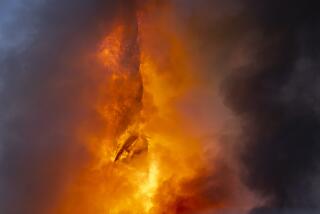Chinese city restores century-old synagogue
HARBIN, China — Two Chinese politicians and an Israeli professor are huddled around an architect’s drawing. “Actually it would be better if the fence rails were shaped like Stars of David instead of crosses,” politely suggests the professor, Dan Ben-Canaan, who is advising on the $16-million project to restore a century-old synagogue in the historic heart of Harbin.
Many Chinese cities have bulldozed their past in the country’s rush to modernity. By contrast, since the late 1990s the northerly city of Harbin has invested millions of dollars in the careful preservation of its turn-of-the-century European architecture. St. Sophia’s, a 1907 onion-domed Russian orthodox cathedral, for example, was renovated in 1997 and made the focal point of a new city square.
“Harbin has a unique history among all other cities in China, and it’s very important that we preserve it,” said Harbin Deputy Secretary-General Liu Xingming, who joined professor Ben-Canaan at the groundbreaking ceremony at the synagogue site this summer.
PHOTOS: Arts and culture in pictures by The Times
The restoration of Harbin’s Old Synagogue, also in Belle Epoque style, which was completed in 1909, will be one of the city’s most ambitious projects. It has been a top priority since China’s central government declared this year that the synagogue was a “protected national treasure,” a designation that puts the building in the same category as the Forbidden City, the Temple of Heaven and the Great Wall.
The New Harbin Synagogue, built in 1921, had a facelift in 2004 and is now a museum documenting Jewish life.
Reconstruction, expected to be completed in May, will not be easy. No blueprints exist, and architects have had to reimagine the building using old photos and memoirs.
Once an orthodox synagogue seating up to 450 people, the building still resembles a Jewish place of worship from its exterior — a Star of David sits atop the rooftop dome. The interior, on the other hand, would be unrecognizable to former congregants. The main prayer hall has been replaced by a warren of rooms, installed in the 1960s when the building was turned into a hospital, and the dilapidated walls are covered in drawings — remnants from its more recent incarnation as a youth hostel.
Despite the challenges, the women’s gallery on the second floor, the men’s prayer hall and rabbi’s bimah platform all will be restored. Attention is being paid to reinstate the smallest of details, down to the color of the walls.
CHEATSHEET: Fall arts preview 2013
This work would not have been possible without the service of Ben-Canaan, who has lived in Harbin for more than a decade. While establishing the Sino-Israel Research and Study Center at Heilongjiang University, he scoured archives of period newspapers, salvaged postcards, collected photos from secondhand markets and tracked down former Jewish residents of Harbin and their families.
Today, Ben-Canaan is most likely Harbin’s only permanent Jewish resident, but the city was once home to up to 25,000 Jews. Their story is closely entwined with the founding of modern Harbin itself. Now a metropolis of nearly 6 million people that is best known for its international snow and ice festival, until the 1890s it was a collection of sleepy fishing villages. The area transformed at the turn of the 20th century, when Russia constructed a rail line through Manchuria to gain quicker access to the port of Vladivostok.
The project’s chief engineer was a Jew by birth, and in Harbin, an important stop on the line, many of the first foreign residents were Jewish entrepreneurs who came predominantly from Russia, Ukraine and Poland.
The makeup of Harbin’s community was quite different from that of the enclave that developed in Shanghai, the Chinese mega-city where there have also been attempts in recent years to retrace its Jewish past, with the Israeli Consulate’s efforts to recover destroyed tombstones and the local government’s establishment of a Jewish refugee museum.
“In Shanghai there were a handful of wealthy Iraqi Jewish families at the beginning, but most came in the 1930s and early 1940s. Escaping from Nazi Europe, they were mostly poor refugees,” Ben-Canaan says. “Harbin’s Jews, by contrast, were wealthy businessmen who came from Czarist Russia and created a thriving community.”
Harbin’s first Jewish residents built empires by trading timber, furs and soybeans, and the extent of their success can be seen in the mansions they built along Central Street. In the early years of the 20th century, nine of the 17 members of the City Council were Jewish, and Jews busied themselves setting up hospitals, banks, cinemas, concert halls and a beer factory.
But tensions existed with the White Russians who had fled en masse to Harbin after the Bolshevik Revolution, The Russian Fascist Party set up its headquarters in the city in 1931; that same year, the Old Synagogue was set on fire. Tough times followed under Japanese occupation, during which many fled, so that by the end of World War II Harbin’s Jews numbered only 3,000.
With the Jewish community long since extinguished, the renovated Old Synagogue and adjacent Jewish middle school will be used as a campus for a new music school, with the former prayer hall to be used for concerts. “It’s fitting, because the Jews were instrumental in bringing classical music to Harbin and, by extension, to China,” Ben-Canaan says.
More to Read
The biggest entertainment stories
Get our big stories about Hollywood, film, television, music, arts, culture and more right in your inbox as soon as they publish.
You may occasionally receive promotional content from the Los Angeles Times.






